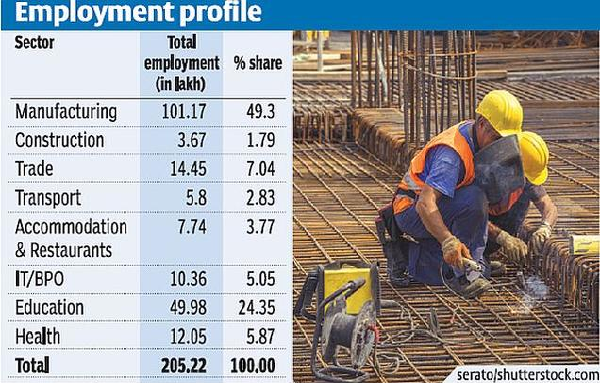Employment in eight key sectors estimated at 205.22 lakh
The total estimated employment in eight selected sectors stood at 205.22 lakh, as per the new series of the draft Quarterly Employment Survey by the Labour Bureau.
The survey for the first time has been expanded to include 18 sub-sectors, such as computer programming, consultancy, retail trade except motor vehicle and motorcycles, food & beverage service, land transport and transport via pipelines, warehousing activities etc, in a bid to bridge the data deficit in the country.
Out of the total 205.22 lakh employed, 199.66 lakh workers (97.29 per cent) were employees and only 5.56 lakh workers (2.71 per cent) were self-employed. Of the total employed, 162.96 lakh (81.62 per cent) were regular, 26.60 lakh (13.32 per cent) contractual and 10.10 lakh (5.06 per cent) casual, says the Quarterly Report on Employment Scenario (New Series).
The survey covered 10,600 establishments between May and July 2016, of which 87.13 per cent were under private ownership and 12.87 per cent under government/PSU ownership.
Manufacturing jobs top
Manufacturing continues to account for highest number of employed at 101.17 lakh workers, constituting 49.30 per cent of the total employment in the eight sectors, followed by the education sector employing 49.98 lakh persons (24.35 per cent), trade employing 14.45 lakh persons (7.04 per cent), health 12.05 lakh persons (5.87 per cent), IT/BPO 10.36 lakh persons (5.05 per cent), accommodation & restaurants 7.74 lakh persons (3.77 per cent), transport 5.80 lakh persons (2.83 per cent) and construction employing 3.67 lakh persons (1.79 per cent) at an all-India level.
Male workers dominate
The gender break-up of employment stays skewed, with males accounting for 72.15 per cent (148.07 lakh) of the total employment, against 27.85 per cent females (57.15 lakh). Female employment was the highest in the education sector (48.96 per cent), followed by health (48.22 per cent) and IT/BPO (31.27 per cent). As per the survey, the number of regular workers is the highest in all eight sectors, except for construction, where casual employees (19.05 per cent) are more than contractual employees (16.53 per cent).
